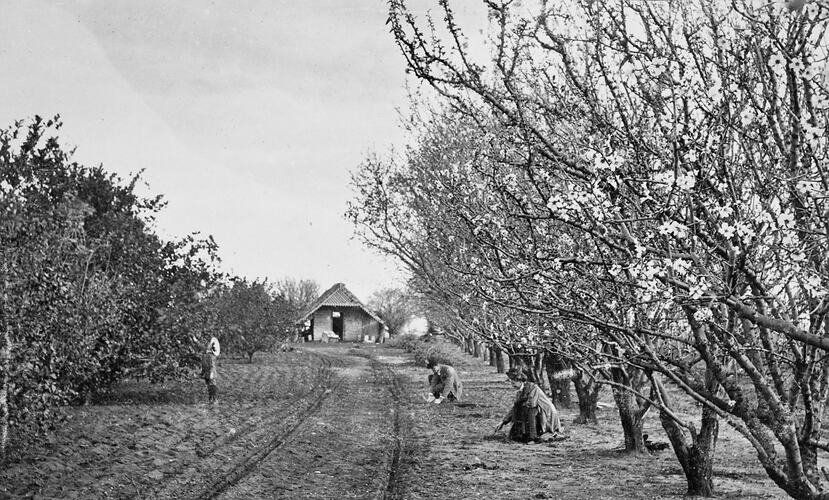Summary
Apples as we know them today are the result of a very long tradition of cultivation that goes back thousands of years to the wild apple forests of central Asia. Apples were domesticated, cultivated and introduced to the rest of the world via ancient trade routes and arrived in Australia with the First Fleet. Apples are never true to their seed, so there are myriad possibilities of new varieties when growing them from seed. Certainty in variety can only be achieved by using techniques such as grafting pieces of branches onto root stock, creating an interdependence between humans apple trees that is vividly described by Henry Thoreau in his 1862 essay on 'Wild Apples'.
For a long time it has been recognised that humans and apples share a very close history (Janson, 1996, Thoreau, 1862, Pollan, 2003). The apple tree has evolved, been domesticated or in fact been civilized in its very own sense (Thoreau, 1862). Most ancient cultures have some sort of reference to fruit, and in many cases apples. Today, apples are cultivated on all continents except for Antarctica (Luby, 2003). The technique of grafting started in Mesopotamia around 4000 years ago (Hancock, 2004, Harris et al., 2002) and plays an essential role in allowing societies to shape and develop apple trees in myriad ways. The results reflect cultural as well as physical conditions and can be traced back through time. Cultivated apple trees are also very prone to diseases and pests, calling for human maintenance and preservation, otherwise the tree may die. There is an intimate relationship between apple trees (and also other fruit trees) and humans that goes beyond mere supply of fruit for culinary purposes.
The mythical, cultural and religious affiliation humans have with fruit is laid out in detail in the pomology literature (Janson, 1996). Dating back to Neolithic farmers who are known to have gathered fruits, to Egyptian, Greek and Roman mythology (i.e. Goddess of fruit Pomona!) to Christian religious affiliation to fruit - fruit and humans have a mutual history; or to borrow Henry Thoreau's words: 'the history of the apple-tree is connected with that of man' (Thoreau, 1862, p.1).
Importantly apple trees are only what they are as a result of human involvement. Apples as we know them today only exist because humans have cultivated them for a long time. Apples will not be true to their parent. They are self-incompatible, meaning that growing a tree from seed will not result in fruit featuring the same characteristics as the tree it grew on (Pollan, 2003, Hancock, 2004, Brown and Maloney, 2003).
Once upon a time there were only wild apples. The wild apple has its origins in Central Asia, in the mountains of Thien Shan in Kazakhstan where the wild apple tree is still the main forest tree today (Hancock, 2004). It is thought that the wild apple Malus sieversii, the ancestor of today's domesticated apple, Malus domestica, travelled via ancient trade routes from Asia to Persia and the Middle East and then on to the Greeks and Romans and subsequently to the rest of Europe (Thoreau, 1862, Vavilov, 1929, Harris et al., 2002, Hancock, 2004, Luby, 2003).
In more recent history the apple has spread from Europe to other parts of the world. Spanish, Portuguese and British colonists brought the apple to the Americas in the 16th and 17th centuries and a little later apples were introduced into the colonies of Australia (1788) and New Zealand (1813) (Luby, 2003).
While today's main use of apples is for raw consumption, this is only a relatively recent practice. In the past apples were primarily used for cooking or for making cider (Pollan, 2003, Luby, 2003). Today's benchmark of a good apple appears to be the sweetness of the apple, whereas for most of the apple's existence, sweetness was less paramount, probably not because sweetness was undesirable, but rather because apples were not consumed in their raw state. Part of the reason for this is that prior to the 20th century, raw fruit and vegetables were generally considered to be harmful to human health (Henzell, 2007).
While there are thousands of apple varieties (excluding the many wild varieties still growing in the wild apple forests of Kazakhstan!), only dozens of varieties are grown for commercial use and sold in mainstream supermarkets around the world.
References
Brown, S. & Maloney, K. 2003. Genetic Improvement of Apple: Breeding, Markers, Mapping and Biotechnology. In: Ferree, D. & Warrington, I. (eds.) Apples - Botany, Production and Uses. Oxon: Cabi Publishing.
Hancock, J. 2004. Plant Evolution and the Origin of Crop Species, Oxon, Cabi Publishing.
Harris, S., Robinson, J. & Juniper, B. 2002. Genetic clues to the origin of the apple. Trends in Genetics, 18, 426.
Henzell, T. 2007. Australian agriculture: its history and challenges, Collingwood, Vic. : CSIRO Publishing, 2007.
Janson, H. F. 1996. Pomona's harvest: an illustrated chronicle of antiquarian fruit literature / H. Frederic Janson, Portland, Or. : Timber Press, c1996.
Luby, J. 2003. Taxonomic Classification and Brief History. In: Ferree, D. & Warrington, I. (eds.) Apples - Botany, Production and Uses. Oxon: Cabi Publishing.
Pollan, M. 2003. The botany of desire: a plant's-eye view of the world / Michael Pollan, London : Bloomsbury, 2003.
Paperback ed.
Thoreau, H. D. 1862. Wild Apples [electronic resource] / Henry David Thoreau, Project Gutenberg, 2003.
Vavilov, N. I. 1929. The role of Central Asia in the origin of cultivated plants. Origin and Geography of Cultivated Plants. Cambridge University Press.
More Information
-
Keywords
-
Authors
-
Article types
